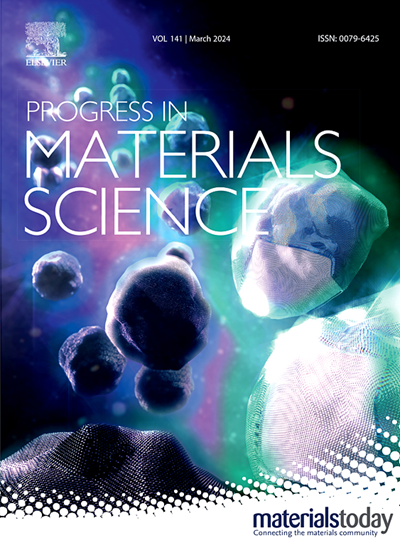电化学CO2转化金属氧化物的形态和界面调整研究进展
IF 40
1区 材料科学
Q1 MATERIALS SCIENCE, MULTIDISCIPLINARY
引用次数: 0
摘要
电化学CO2还原反应(CO2RR)是实现碳捕获与利用的一种非常有前途的技术途径。大量的金属氧化物(MO)纳米结构被设计成具有独特晶体结构的优点,从而在电化学CO2RR方面取得了显著的进展。然而,需要更多的努力来正确地阐明它们的合成、结构和活性之间的复杂关系。从这个角度来看,本综述主要集中在:(i)关键因素的结构工程(例如,晶体面,缺陷,界面,自旋和形态),(ii)控制这些结构特征发展的合成策略,(iii)结构-活性关系,(iv) CO2转化过程中多个质子/电子转移步骤的催化机制(例如,转化为C1(例如,CO, CH4和CH3OH)或C2+产物(例如,C2H4, C2H6, C2H5OH, CH3COOH和C3H7OH)),以及(v)各种电催化剂的性能(例如,以法拉第效率、电流密度和稳定性来表示)。基于原位/非原位技术结合密度泛函理论,讨论了控制催化剂形态和关键中间体吸附/转移行为的因素。总的来说,这篇综述的目的是提供关键的见解,可以指导下一代基于mo的电催化剂的合理设计,以实现高效和选择性的CO2电还原。本文章由计算机程序翻译,如有差异,请以英文原文为准。
Advances in morphological and interfacial tuning of metal oxides for electrochemical CO2 conversion
The electrochemical CO2 reduction reaction (CO2RR) has been recognized as a highly promising technological approach for realizing carbon capture and utilization. A plethora of metal-oxide (MO) nanostructures have been designed with the merits of unique crystal structures to achieve noticeable advances in the electrochemical CO2RR. However, more efforts are needed to properly elucidate the intricate relationships between their synthesis, structure, and activity. In this perspective, this review centers on: (i) the structural engineering of key factors (e.g., crystal facet, defect, interface, spin, and morphology), (ii) synthesis strategies governing the development of such structural features, (iii) structure–activity relationships, (iv) catalytic mechanisms of multiple proton/electron transfer steps in conversion of CO2 (e.g., either into C1 (e.g., CO, CH4, and CH3OH) or C2+ products (e.g., C2H4, C2H6, C2H5OH, CH3COOH, and C3H7OH)), and (v) the performance metrics of diverse electrocatalysts (e.g., in terms of Faradaic efficiency, current density, and stability). The factors controlling the catalyst morphology and the adsorption/transfer behavior of the key intermediates are also discussed based on in situ/ex-situ techniques combined with density functional theory. Collectively, this review aims to provide critical insights that can guide the rational design of next-generation MO-based electrocatalysts for efficient and selective CO2 electroreduction.
求助全文
通过发布文献求助,成功后即可免费获取论文全文。
去求助
来源期刊

Progress in Materials Science
工程技术-材料科学:综合
CiteScore
59.60
自引率
0.80%
发文量
101
审稿时长
11.4 months
期刊介绍:
Progress in Materials Science is a journal that publishes authoritative and critical reviews of recent advances in the science of materials. The focus of the journal is on the fundamental aspects of materials science, particularly those concerning microstructure and nanostructure and their relationship to properties. Emphasis is also placed on the thermodynamics, kinetics, mechanisms, and modeling of processes within materials, as well as the understanding of material properties in engineering and other applications.
The journal welcomes reviews from authors who are active leaders in the field of materials science and have a strong scientific track record. Materials of interest include metallic, ceramic, polymeric, biological, medical, and composite materials in all forms.
Manuscripts submitted to Progress in Materials Science are generally longer than those found in other research journals. While the focus is on invited reviews, interested authors may submit a proposal for consideration. Non-invited manuscripts are required to be preceded by the submission of a proposal. Authors publishing in Progress in Materials Science have the option to publish their research via subscription or open access. Open access publication requires the author or research funder to meet a publication fee (APC).
Abstracting and indexing services for Progress in Materials Science include Current Contents, Science Citation Index Expanded, Materials Science Citation Index, Chemical Abstracts, Engineering Index, INSPEC, and Scopus.
 求助内容:
求助内容: 应助结果提醒方式:
应助结果提醒方式:


